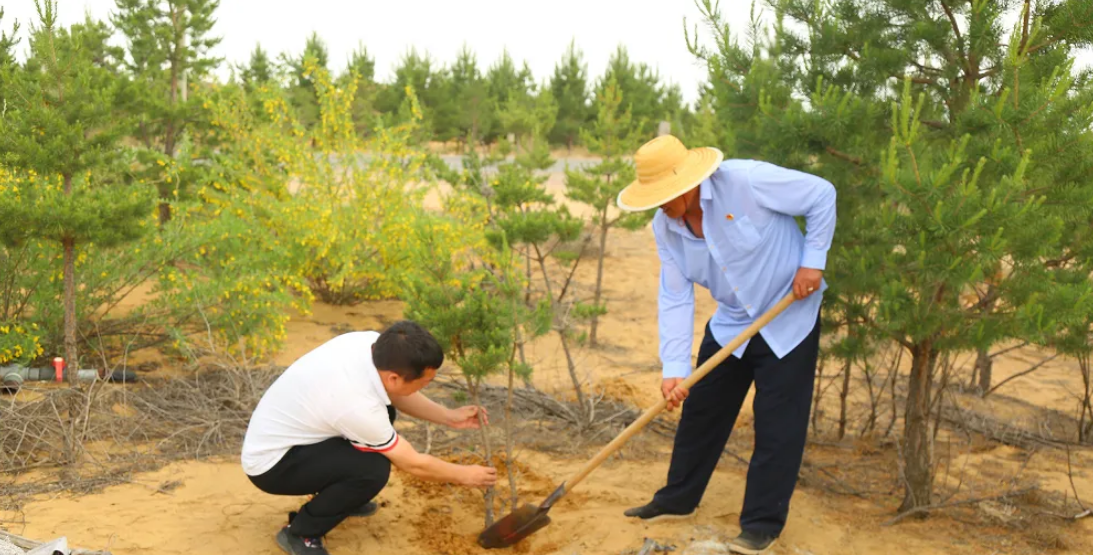
For over 50 years, Ulziidelger, a 71-year-old Mongolian farmer from Inner Mongolia’s Otog Front Banner, has turned his childhood dream of greenery into a lifelong mission. Growing up in a desert landscape, he learned early that survival meant fighting sand with trees.
The roots of his mission trace back to his family. In the 1960s, his mother planted two willow saplings (幼树) outside their new home, saying, “A house truly becomes a home when a tree is planted in front of it.” This simple act started a family tradition. Back then, his family owned almost 570 hectares of pasture. Most of them, however, were covered by sand. By age 11, Ulziidelger was planting trees after school there.
Marriage in 1972 brought a partner in his cause. “Our land was swallowed by sand — planting trees was our only hope,” he recalled. With no vehicles, he and his wife carried saplings on their backs through soft sand. They studied water sources and soil to help young trees survive. To save time, they ate millet (小米) soaked (浸泡) in hot water from insulated jars, sometimes adding meat for energy. “It kept us working without going home for lunch,” he explained.
By 2000, their efforts transformed all sandy land into green fields. But Ulziidelger didn’t stop. When China launched an environmental program in 2004, as village Party chief, he organized training sessions. He brought forestry experts to teach villagers and shared his own desert-fighting techniques. The results amazed everyone: vegetation cover rose from near zero to 97%. Sandstorms that once buried homes now rarely occur. Ulziidelger’s work earned him honors like “eco-warrior” and “environmental guardian”.
As Ulziidelger ages, it has become increasingly challenging for him to continue planting trees. Facing health challenges, he prepares to pass the task to his son and grandson. “This may be my last year planting trees, but our fight will continue,” he said.
原创编写 版权所有 侵权必究! 每日更新 个性化阅读 英语飙升!
1.1. What inspired Ulziidelger to start his tree-planting mission?
A Government policies on desert control.
B His dream of becoming a forestry expert.
C His mother’s tree-planting tradition.
D Scientific research on soil improvement.
解析:选C。C 细节理解题。根据第一段的“he learned early that survival meant fighting sand with trees”和第二段的“In the 1960s, his mother planted two willow saplings... This simple act started a family tradition.”可知,他母亲种植柳树苗的行为开启了家庭传统,也促使他开始了植树使命。A选项中国的环保项目是在2004 年,在他开始植树使命之后;B选项未提及;D选项沙尘暴频繁袭击村庄是他面临的问题,并非最初激励他植树的原因。故选C。
2.2. How did Ulziidelger and his wife save time during planting?
A By using advanced vehicles.
B By having lunch in the field.
C By hiring local workers.
D By following experts’ schedules.
解析:选B。B细节理解题。根据第三段的“To save time, they ate millet soaked in hot water from insulated jars, sometimes adding meat for energy.”以及“It kept us working without going home for lunch”可知,为节省时间,他们把午餐带到劳作的地方,而不是回家吃午饭。A选项与原文“With no vehicles”不符;C选项未提及;D选项他们是持续种树,并非只在周末种。故选 B。
3.3. What can we infer about Ulziidelger’s work in tree-planting?
A Effortless due to their experience.
B Unsupported by the 2004 program.
C Significantly transformed the environment.
D Limited to his personal land.
解析:选C。C 推理判断题。根据第四段的“The results amazed everyone: vegetation cover rose from near zero to 97%. Sandstorms that once buried homes now rarely occur.”可知,他的植树工作结果令所有人惊叹:植被覆盖率从近乎零上升到97%。曾经掩埋房屋的沙尘暴如今鲜少发生。即对当地环境产生了巨大影响。A选项,文中提到他们背着树苗在软沙中行走,研究水源和土壤等,说明植树工作并不容易;B选项,2004年中国启动环保项目后,他组织培训,邀请专家等,说明该项目对他的工作有帮助;D选项,他作为村党支部书记组织培训,分享技术,说明他关心村民,并非只关注自己的土地。故选C。
4.4. What does Ulziidelger’s decision to pass the task to his family show?
A The need for professional training.
B His dissatisfaction with current progress.
C Challenges in modern agriculture.
D The importance of continuing the mission.
解析:选D。D 推理判断题。最后一段提到他因健康问题准备让儿子和孙子接班,并强调“斗争会继续”,表明他希望使命代代传承。故选D。
